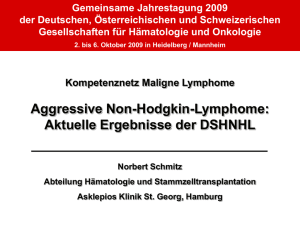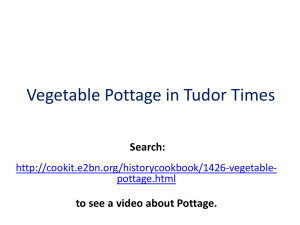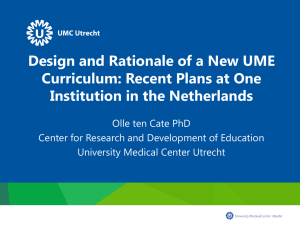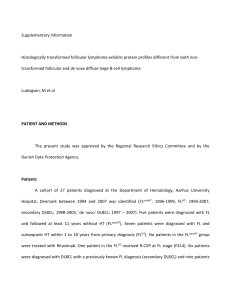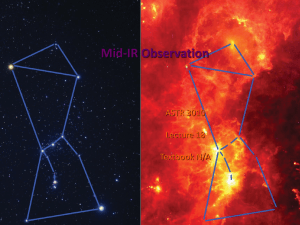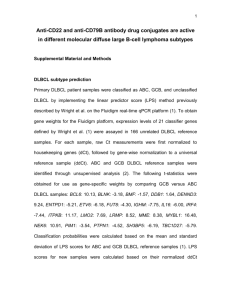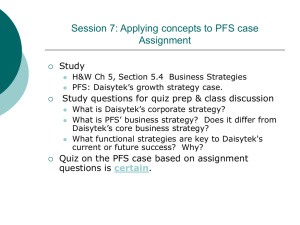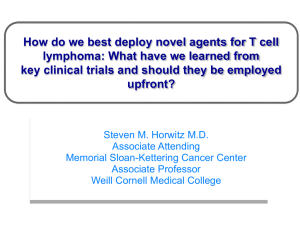R-CHOP14 - Oncology
advertisement
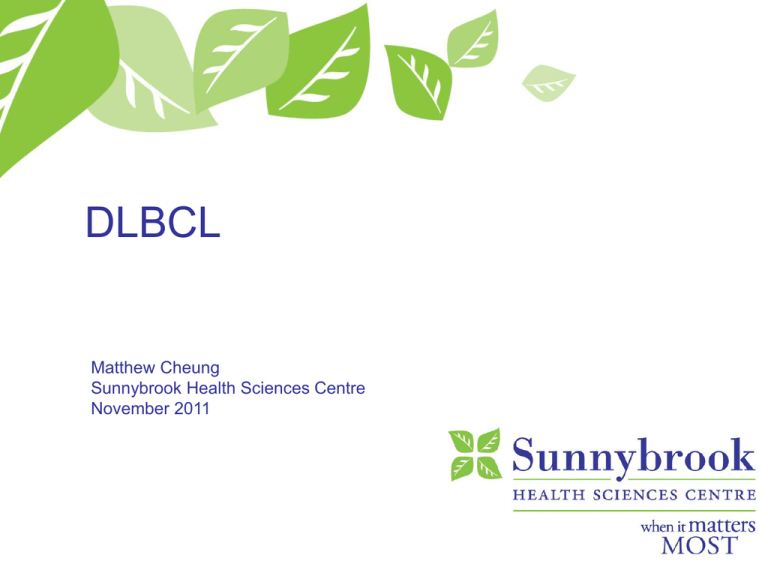
DLBCL Matthew Cheung Sunnybrook Health Sciences Centre November 2011 Outline • Review of DLBCL – A focus on key trials/advances – Highlights of disease/treatment mechanisms • Advanced stage • Limited stage • Relapsed Key Points • Current classification system - WHO Composite lymphomas (13%) Small lymphocytic (6%) Follicular (22%) Mantle cell (6%) Peripheral T cell (6%) Marginal zone B cell, MALT (5%) Diffuse large B cell (31%) Other subtypes with a frequency < 2% (9%) Marginal zone B cell, nodal (1%) Lymphoplasmacytic (1%) Ann Arbor Staging Lymphomation.com Comparison of CHOP with Three Intensive Chemotherapy Regimens for Advanced NHL Overall Survival Fisher, NEJM 1993 CD20: An Ideal B-cell Target • 297 amino acid membrane-associated phosphoprotein (33–37 kD) – – – • B-cell lineage antigen, not on: – • Not shed No known membrane/secreted molecular analogues (target interference) Calcium channel function (?) Stem cells, early pre-B cells, or plasma cells Anti-CD20 binding: – – Does not down-modulate expression of CD20 Does not cause internalization of CD20 Johnson P, Glennie M. Semin Oncol. 2003;30:3-8. Golay J et al. Blood. 2000;95:3900–3908. Basic Science - Mechanism Mechanisms of Antibody-Mediated Cell Killing NK cell Target cell Target cell Antibody-dependent cellular cytotoxicity (ADCC) Target cell Apoptosis via induction of intracellular signaling pathways Complement-dependent cytotoxicity (CDC) Coiffier, NEJM 2002 • Clinical trials – Infusional side effects (~10% grade III/IV) • 2009 - product monograph – Hepatitis B reactivation (1 in 10,000) – Bowel perforation (1 in 20,000) – PML (cases) International Prognostic Index One point each for: • • • • • Age >60 years Performance status 2+ LDH >ULN Stage III or IV More than one extranodal site Low risk: 0-1 factor, Int: 2-3, high: 4-5 IPI Outcome According to Revised IPI (R-IPI) Risk Group Very Good Good Poor # % 4-year 4-year Factors Patients PFS (%) OS (%) 0 10 94 94 1,2 45 80 79 3,4,5 45 53 55 Sehn et al, ASH 2006 Progression-Free Survival According to Revised IPI (R-IPI) Very Good 1.0 Percent Survival .9 .8 Good .7 .6 Poor .5 .4 .3 .2 P<0.0001 .1 0.0 0 1 2 3 4 5 DLBCL (ABC type) GCB subtype correlated with better survival NEJM, 2002 IHC can be used to differentiate GC vs. non-GC Hans algorithm Muris algorithm Nyman algorithm Nyman H et al, Modern Pathology 2009; 22 : 1094-1101 Nyman Muris Hans Nyman H et al, Modern Pathology 2009; 22 : 1094-1101 Rituximab + CHOP is recommended in all the following except? • • • • • Transformed NHL (FL --> DLBCL) Primary Mediastinal B-cell Lymphoma DLBCL HIV-related DLBCL Pediatric DLBCL AMC RCT of CHOP-R vs. CHOP (+ HAART) CHOP + R CHOP p-value Regimen CHOP+R + rituximab q month x3 CHOP n 96 47 CR 57% 49% NS Death due to lymphoma 10% 19.5% NS Kaplan et al. (AMC Study), Blood 2005 Rituximab and Infection Infectious deaths CHOP + R CHOP p-value 14% 2% 0.027 n=14 patients dying of infection -7 culture-positive sepsis -4 culture-negative sepsis -2 pneumonia -1 fungal 60% deaths in patients with CD4 <50 40% deaths during the maintenance phase of R Kaplan et al. (AMC Study), ASH 2003 Alternatives to R-CHOP-21 • R-CHOP-14 (GELA study) • R-EPOCH – Dose-adjusted/continuous infusion – Phase III pending LNH03-6B GELA Trial IPI ≥1, age 60-80 N = 202 R-CHOP14 N = 103 R-CHOP21 N = 99 Complete treatment received : N = 73 Premature withdrawal : N = 30 Complete treatment received : N = 74 No treatment received : N = 1 Premature withdrawal : N = 24 Dose-intensity Is R-CHOP14 given every 14 days ? R-CHOP14 Median interval between two cycles 15 days (9 – 70) Median dose-intensity R-CHOP21 21 days (19 – 63) 18/103 patients in R-CHOP14 group received R-CHOP ≥ 18 days R-CHOP14 R-CHOP21 Cyclo 84 % 96% Dox 83 % 95 % R-CHOP14 = 125 % of R-CHOP21 R-CHOP14 R-CHOP21 G-CSF use 90 % 68 % LNH03-6B GELA Trial: Toxicities Patients (%) • Hematologic toxicities greater for R-CHOP14 100 90 80 70 60 50 40 30 20 10 0 R-CHOP14 R-CHOP21 83 83 73 69 50 36 26 22 21 22 Grade 3/4 Grade 3/4 Grade 3/4 RBC Grade 3/4 Leukocytes Neutrophiles Hemoglobin Transfusion Platelets 15 11 Platelet Transfusion • Patients on R-CHOP14 had higher rates of febrile neutropenia, hospitalization, and death due to toxicity Delarue R, et al. ASH 2009. Abstract 406. LNH03-6B GELA Trial: Results Outcome 2-yr EFS, % Median EFS, mos 2-yr PFS, % Median PFS, mos 2-yr OS, % CR + CRu ORR Delarue R, et al. ASH 2009. Abstract 406. R-CHOP21 (n = 99) 61 Not reached 63 Not reached 70 R-CHOP14 (n = 103) 48 22 49 23 67 P Value 75 84 67 81 NS NS .11 -.12 -.37 Event-free survival Median EFS : - 22 months (R-CHOP14) vs NR (R-CHOP21) 2-year EFS : - 48% (R-CHOP14) vs 61% (R-CHOP21) Overall survival -2-year OS: - 67% (R-CHOP14) vs 70% (R-CHOP21) Role of upfront high-dose therapy and ASCT? • Prior to rituximab era: – Phase II studies suggested 60-80% of high-risk aggressive lymphomas could achieve long-term PFS. – Eleven phase III studies have now addressed this question – mixed results – Meta-analyses – heterogeneity and conflicting results preclude definite answer re: benefit of HDT/ASCT • Low-risk patients do not benefit compared to conventional therapy • Benefit in the era of rituximab unknown – ASBMT – upfront transplant indicated for high-intermediate and high-risk IPI groups – NCCN – appropriate for trials Randomized phase III U.S./Canadian intergroup trial (SWOGS9704) comparing CHOP-R for eight cycles to CHOP-R for six cycles followed by autotransplant for patients with high-intermediate (H-Int) or high IPI grade diffuse aggressive non-Hodgkin lymphoma (NHL) • Study design: Stiff PJ Abstract 8001 ASCO 2011 Outcome % ASCT arm Conventional arm Hazard ratio P-value 2-year PFS 69 56 1.72 .005 2-year OS 74 71 1.24 .16 Stiff PJ Abstract 8001 ASCO 2011 Other Alternatives: • Cardiac toxicity – Substitution of etoposide (R-CEOP) –ASH 2009 – 50mg/m2 day 1 and 100mg/m2 po days 2-3 – Pts with LV dysfunction or intolerance of doxorubicin – BCCA Retrospective/Population review (n=81) Elderly • R-mini-CHOP (ASH 2010) • • • • • • doxorubucin 25mg/m2 N=151 patients ORR 74% (CR 40% and CRu 23%) 2-year PFS 47.4% 2-year OS 59% FN 7% • Pre-treatment (vincristine/prednisone) • Liposomal doxorubicin • DA-(E)POCH Revised Response Criteria for Malignant Lymphomas from the Members of the International Harmonization Project of the Competence Network Malignant Lymphoma Cheson BD, Pfistner B, Juweid ME, Spect L, Rosen ST, Gascoyne R, Stroobants S, Diehl V. Rationale • IWG response criteria (1999) • extranodal sites not included • dependent on older technologies/methods – CXR/CT/MRI unable to distinguish tumour vs. necrosis – SPECT-gallium outdated • unclear (?CRu) Response Assessment of Aggressive NHL IWC + PET IWC CR CRu PR SD PD Total CR 17 0 0 0 0 17 CRu 5 0 2 0 0 7 PR 10 0 9 0 0 19 SD 2 0 1 6 0 9 PD 1 0 0 0 1 2 Total 35 0 12 6 1 54 Juweid, M. E. et al. J Clin Oncol; 23:4652-4661 2005 IWC + PET IWC CR CRu PR SD PD Total CR 17 0 0 0 0 17 CRu 5 0 2 0 0 7 PR 10 0 9 0 0 19 SD 2 0 1 6 0 9 PD 1 0 0 0 1 2 Total 35 0 12 6 1 54 Juweid, M. E. et al. J Clin Oncol; 23:4652-4661 2005 IWC + PET CR CRu PR SD PD Total CR 17 0 0 0 0 17 CRu 5 0 2 0 0 7 PR 10 0 9 0 0 19 SD 2 0 1 6 0 9 PD 1 0 0 0 1 2 Total 35 0 12 6 1 54 IWC Juweid, M. E. et al. J Clin Oncol; 23:4652-4661 2005 Progression-free survival by the International Workshop Criteria (IWC) and IWC plus positron emission tomography (PET) based on the KaplanMeier method Juweid, M. E. et al. J Clin Oncol; 23:4652-4661 2005 IHP Recommendations • FDG PET or PET/CT should be integrated into new IWG criteria • Pre-treatment - recommended, not required • Response assessment – required for DLBCL/HL • CR - new definition • No clinical evidence of disease or symptoms • Residual mass/node of any size allowable if PET negative if typical FDG-avid lymphoma or PET positive prior to treatment • Regression to <1.5 cm in GTD if >1.5 cm pretreatment if variable FDG-avid lymphoma or PET negative prior to treatment • Bone marrow negative • CRu - now obsolete Conclusion - Advanced DLBCL • R-CHOP x 6 cycles is the standard of care – In elderly population: • expect to cure ~60% • expect long-term survival ~70% – – – – – 6 cycles equivalent to 8 cycles (and less neurotoxicity) R-CHOP-21 likely as good as R-CHOP-14 (and better tolerated) Role of upfront ASCT – still unclear Rituximab not recommended for HIV+ DLBCL No role for maintenance rituximab in DLBCL • Prognosis – Improved in the rituximab era – Also determined by gene expression profile • Response criteria – PET is now included at the end of therapy to confirm CR vs. PR (and eliminate CRu designation) Eligible Patients Stage I – II aggressive NHL CHOP x 8 CHOP x 3 + IF-RT 40 - 55 Gy SWOG prospective RCT of 401 patients Patients with bulky ( > 10 cm ) stage II were not included Miller et al Update : Ann Hematol 2001; 80 Published only as an abstract Results: With a median FU of 8 years: PFS and OS overlap at 7 and 9 years respectively • Updated SWOG study – suggests that XRT cannot replace inadequate/abbreviated chemotherapy • Is there a group of patients that do well with abbreviated chemotherapy + RT? Fisher, Miller et al Am Soc Hematol Educ Program 2004: 221-236 Updated analysis of SWOG 8736 accounting for IPI risk factors Patients with unfavourable risk factors do poorly with only 3 cycles of CHOP In contrast, in patients with no stage adjusted risk factors, 3 CHOP + RT yielded a 5Y OS of 94% IS THERE ANY ROLE FOR RT? For patients in CR after CHOP, low-dose RT prolonged DFS and improved local control, but yielded no survival benefit Horning JCO 2004 8 CHOP 8 CHOP + RT 6Y DFS 56% 73% p = 0.05 6Y TTP 67% 80% p = 0.06 6Y OS 71% 82% p = 0.24 Exam Answer: • CHOP-R x 3 cycles and IFRT – However….if >1 IPI risk factor - evolving evidence suggests high risk of late (?distant) relapses - would recommend 6 cycles – IFRT appears to improve long-term local control Failure of Primary Therapy • Patients who relapse after a good response have poor prognosis • Patients who progress on therapy do even worse • Only curative potential is aggressive chemotherapy followed by stem cell transplantation – <65 years – Functionally well Parma Study CORAL trial: R-ICE vs R-DHAP ARM 1: R maintenance ARM A: R-ICE C1 R A N D O M I S E D C2 C3 S9 S0 S3 S6 Evaluation S0 S3 S6 S9 C1 C2 ARM B: R-DHAP BEAM + autograft R A N D O M I S E D +M1 +M3 +M5 +M7 +M9 +M11 +M12 Evaluation +M3 +M7 C3 ARM 2: Observation +M12 Coral Study: Patient Characteristics • Chemotherapy: CHOP-like 85% ACVB-like rituximab 13% 62% 23% ─Local radiation • Age-adjusted IPI (PS, stage, LDH) • Prior CR/CRu progression on Rx 0,1 2,3 50% 50% 65% 11% CORAL: main results CR Overall Response ICE DHAP 36% 40% 63% 64% C Gisselbrecht, et al, J Clin Oncol 2010 Secondary analysis: importance of prior rituximab, time to progression Progression < 12 mos Progression > 12 mos C Gisselbrecht, et al, J Clin Oncol 2010 • • • At a median follow-up of 45 months, mobilization-adjusted ORR comparable after induction therapy – 51.5% for R-ICE vs 56.5% for R-DHAP – Fewer adverse events observed with R-ICE EFS and OS rates comparable between R-ICE (29% and 48%, respectively) and RDHAP (33% and 51%) Nearly all patients achieved PR or better after induction therapy Outcome 4- years % R-maintenance No further treatment P-value EFS 55 53 .7435 PFS 55 57 .8314 OS 64 67 .7547 Gisselbrecht C. Abstract 8004 ASCO 2011 Limitations to second line therapy All relapses 100 Eligible for intensive salvage 50 Response to second line therapy 25 Able to proceed to ASCT 20 Long-term survivors 10
